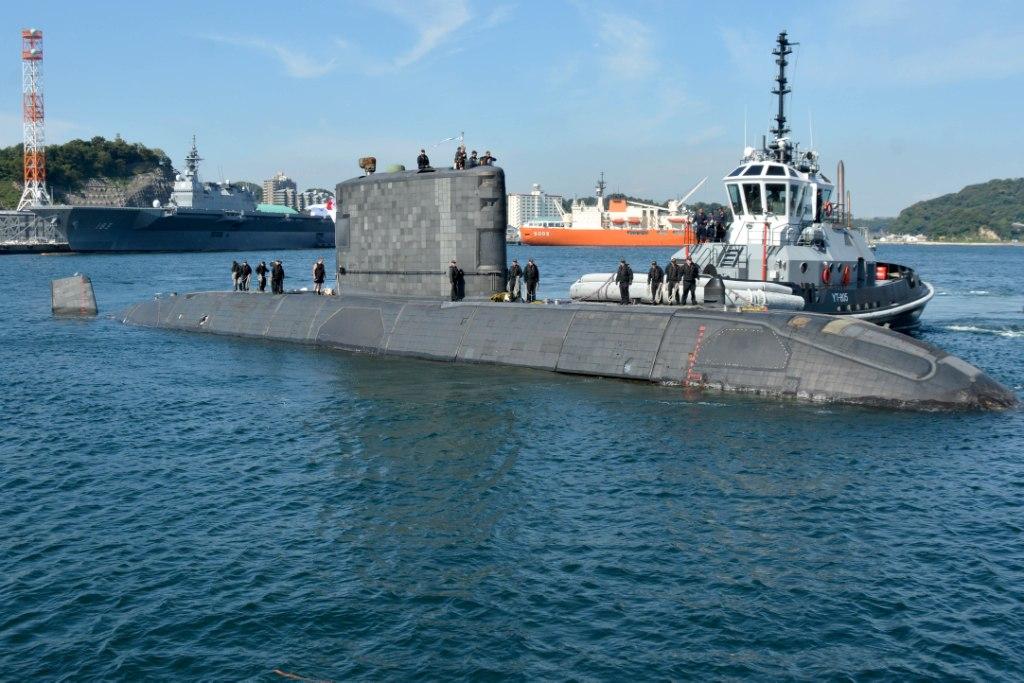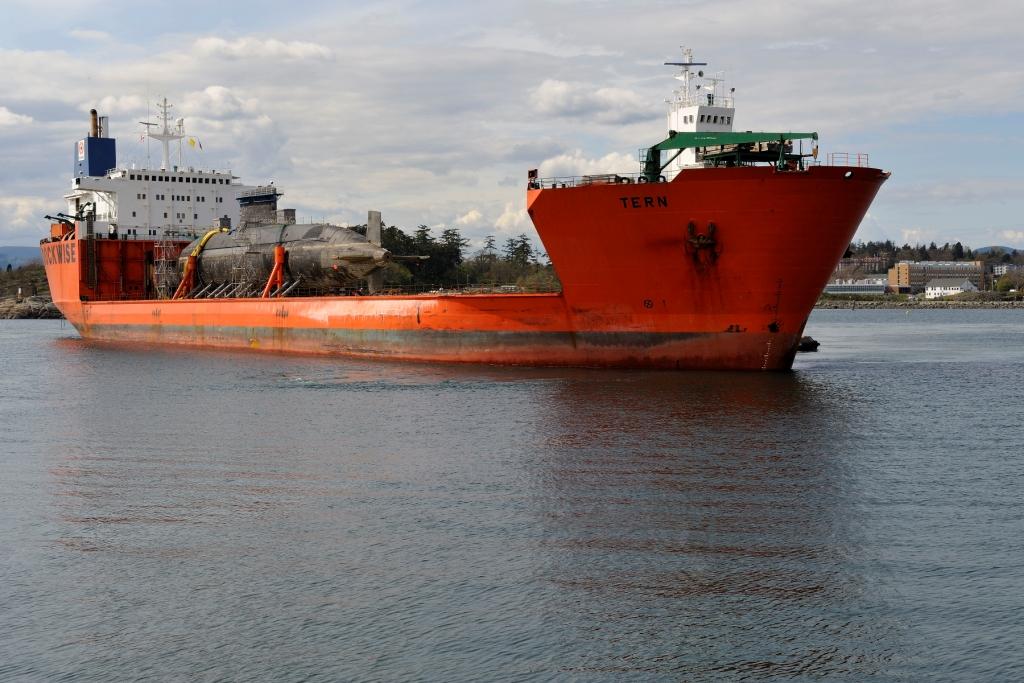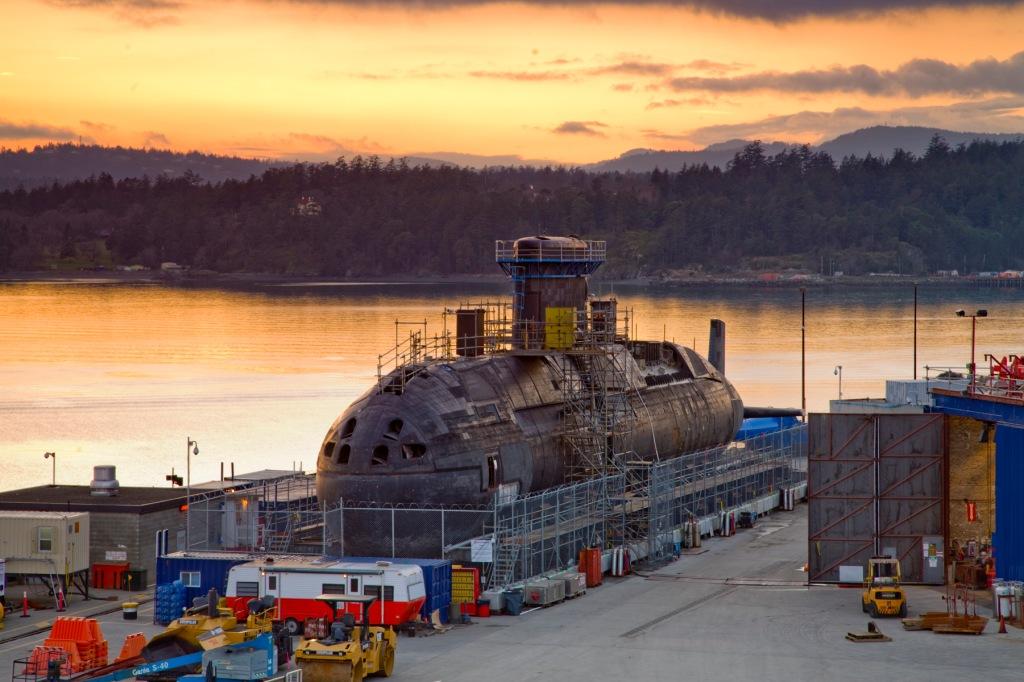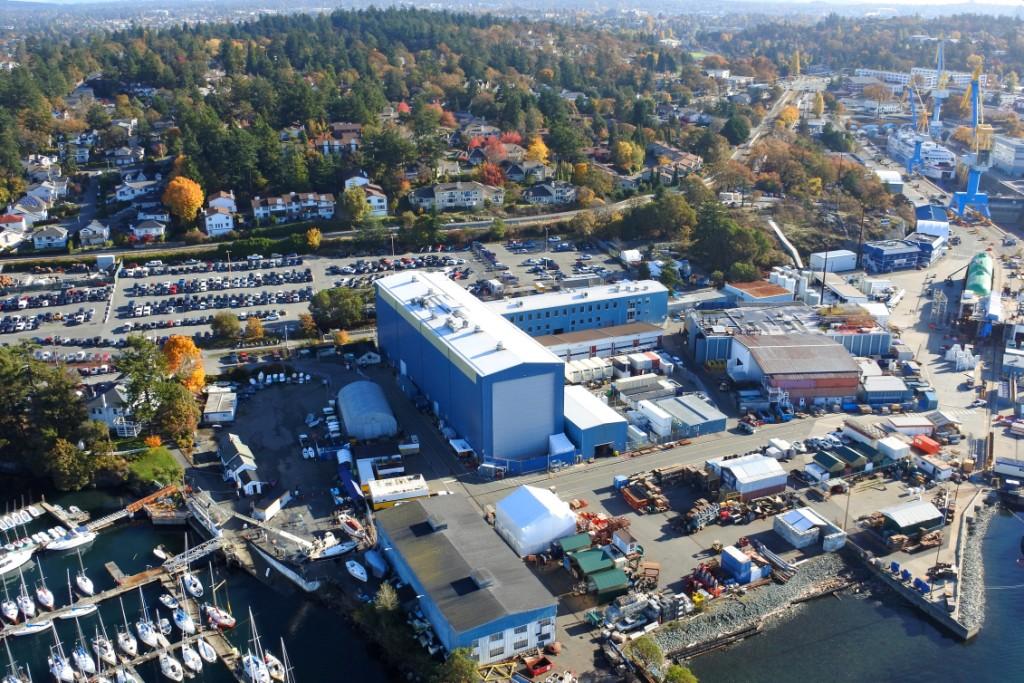BY Joetey Attariwala
 The Victoria Class submarines of the Royal Canadian Navy (RCN) are often misunderstood and sometimes misrepresented. These vessels were originally known as the Upholder Class when they were built for the Royal Navy. These submarines were decommissioned after a short length of service, after which Canada purchased them from the British Government in 1998. Various problems soon arose with these ships, which caused people to have negative views of the program and one can perhaps understand those early perspectives particularly after a tragic accident occurred aboard HMCS Chicoutimi during its trans-Atlantic crossing on its way to Canada.
The Victoria Class submarines of the Royal Canadian Navy (RCN) are often misunderstood and sometimes misrepresented. These vessels were originally known as the Upholder Class when they were built for the Royal Navy. These submarines were decommissioned after a short length of service, after which Canada purchased them from the British Government in 1998. Various problems soon arose with these ships, which caused people to have negative views of the program and one can perhaps understand those early perspectives particularly after a tragic accident occurred aboard HMCS Chicoutimi during its trans-Atlantic crossing on its way to Canada.
With all that said, much of the negativity surrounding these submarines is based on events which in most cases are over a decade in the past, and bear little relationship to the Victoria Class submarines of today, which one can arguably say are very capable strategic assets of the RCN.
One of the biggest issues in speaking about submarines is the very essence of their purpose. Often referred to as the ‘Silent Service’, submarine operations are stealthy and covert by design, and are therefore seldom spoken about. Another fact which navies, writ large, face is that once vessels are beyond the horizon, they are often forgotten about, with the exception of family and friends, of course. Submarines face an additional hurdle in this regard since their business is conducted under the surface of the ocean, and therefore they are almost always out of sight.
FAILURE IS NOT AN OPTION
That fact however, is at the core of why submarines are so important to a modern navy. The fact that they are stealthy means they are excellent platforms from which to conduct covert missions, whether it be anti-submarine or anti-ship warfare, electronic and signals intelligence, and Special Forces operations. There is no better platform from which to do these missions, but that capability comes at a cost in both time and money - and that is principally due to very strict and precise maintenance and support measures applied to submarines, because in the safety critical subsurface world, failure is not an option.
One only has to board a submarine, even just once, to get an immediate appreciation for the incredible complexity of these boats. These vessels are a marvel of engineering and technology, and are often regarded as the most complex man-made platforms in the world, ahead of the Space Shuttle. Modern day naval submarines - which are essentially warships under the sea - have complex piping, wiring, ducting and all the other things which are necessary to sustain human life while traveling on the water and under the water - and doing all of that safely and effectively over an operational lifetime which typically spans decades.
In referring to the Victoria Class, the Government of Canada has said, “Victoria-class submarines are extremely versatile, allowing them to operate in any weather condition for periods of up to 45 days, and perform in a variety of roles to fulfill Canada’s requirements for a balanced, multi-purpose and combat-effective naval fleet.”
VISSCCONTRACT IN EFFECT THROUGH 2023
These diesel-electric submarines are based on each coast in both Halifax and Esquimalt, but it is in Esquimalt where the submarine fleet is principally supported, and where major refits and extended docking periods are carried out. Delivering this highly specialized support to Canada’s submarine fleet is Babcock, a world renowned naval support expert and the provider of the VictoriaClass In-Service Support Contract (VISSC), which was awarded in 2008 through a competitive process.
For this program, Babcock works cooperatively with the RCN, the Department of National Defence (DND), and Public Services and Procurement Canada (PSPC). The support and maintenance agreement extends to 2023, and represents a potential investment of over CAD $3.6 billion.
Submarines work on a time-based maintenance and capability upgrade methodology. Multi-year deep maintenance periods for the Victoria Class are known as Extended Docking Work Periods (EDWP), and are conducted under the management of Babcock as part of VISSC. An EDWP involves the comprehensive maintenance, repair, overhaul or upgrading of over 200 systems that are needed to enable six to nine years of operation for each submarine. Some of these enhancements and improvements include AN/BQQ-10(v) 7 submarine sonar upgrades, mast upgrades, combat system upgrades, and many others.
Under VISSC, Babcock is responsible for bringing together support from original equipment manufacturers, engineering services, and repair and overhaul management. Mike Whalley, President of Babcock Canada, spokewith CDR about the significance of Canada’s submarine fleet and the work that the company provides through VISSC. He explained, “What we as a community don’t speak enough about is the good work that’s been going on over the past decade to rebuild a capability in Canada for looking after these highly complex machines. The good work that’s gone on since the program encountered troubles in its early days is quite significant and should be shared.”
EMPLOYING 400 SKILLED ENGINEERS AND TECHNICIANS
Whalley added, “We started with very modest facilities in Esquimalt, but today we have custom-built facilities and we employ 400 people on this project across Canada, and they’re all highly skilled engineers, technicians and project managers; we also employ Seaspanas our principal subcontractor and partner, so that’s another 300 people. That’s 700 people in industry who are supporting Canada’s submarines. The vital support provided by our submarine enterprise partners at the FMF [Fleet Maintenance Facility] are in addition to that, as are those who support our supply chain. It’s a highly-skilled workforce and capability which we are proud to contribute to.”
According to the RCN, the submarine fleet became operational in February 2015, and has now reached a state of stability, and is routinely deploying as strategic maritime assets. Of the four submarines in the RCN fleet, HMCS Windsor is currently operational and stationed in Halifax while HMCS Victoria, HMCS Chicoutimi, and HMCS Corner Brook are on the West coast in Esquimalt.
The most recent configuration of these submarines sees them fitted with U.S. combat systems and weapons systems, which by all accounts are extremely capable. “It’s like having the modern military capabilities of a nuclear submarine without the nuclear propulsion,” said Whalley.
Babcock together with DND, have developed a scheduling model for the Victoria Class that combines a variety of infrastructure and human resources to create a projection of resource demand against the Class. The implementation of the Class Planning toolset has provided DND’s Submarine Program Management Office the flexibility to quickly assess a number of scenarios based on resource constraints such as dock availability and maintenance manpower to determine an appropriate course of management action with a thorough understanding of the associated risks and long-term Class availability implications. As a result of applying the toolset, DND’s submarine enterprise has increased confidence, improved consistency and a more informed decision making process in support of complex asset management.
HMCS Victoria is about to undock and return to service after completing a work period, during which a number of high pressure pipe welds were repaired at Fleet Maintenance Facility Cape Breton. While HMCS Corner Brook, is currently undergoing its EDWP which will include repairs to the damage the submarine sustained during a grounding incident in 2011. This work will include the replacement of some external structure and the sonar bow dome.There will also be upgrades to key combat systems, including the Heavyweight Torpedo (Mk 48 Mod 7AT) which also happens to be used by the United States Navy, Royal Australian Navy, and Royal Netherlands Navy. There are also upgrades to the primary sonar system and installation of a new modern Satellite Communication system, and Communications Intercept capability.
A NEW MILESTONE FOR THE VICTORIA CLASS
The next major milestone for the Victoria Class fleet will come in 2020 with the roll-out of HMCS Corner Brook after her refit. The ship will then conduct camber dive trials in harbour, and systems certification prior to receiving her ‘license to operate’, which will then be followed by workups and operational deployments.
Speaking to CDR was Ryan Hawes, Babcock’sDirector of Submarine Projects, who explained, “In comparison to what she was when she went in to her EDWP, what Corner Brook is going to come out like is night and day. At least 80% of her combat suite will be new.”
HMCS Victoria is scheduled to enter her next EDWP after the completion of HMCS Corner Brook’s EDWP. It is then expected that HMCS Windsor will transit to Victoria for her EDWP in 2023.
“We are now at the point where collectively between Babcock, DND, and FMF, we are delivering quite good availability for the fleet. They’re getting two out of four of the submarines at sea consistently which is good, and there will be occasions when we are slightly above that,” said Babcock’s Whalley.
The first submarine to undergo EDWP by Babcock Canada was HMCS Chicoutimi, Whalley confided to CDR, “The work done on Chicoutimi was particularly challenging as she had fire damaged to repair and was also inactive for a number of years, and had therefore missed some maintenance cycles. Also, since she was the first ship to undergo EDWP as part of the VISSC, we worked very hard with Canadian industry to get a Canadian supply chain established to help support the Victoria Class. We’ve had to be quite innovative in terms of their support.”

He added, “The submarines were built to the highest design and construction standards of the day. As modern analysis techniques are increasingly sensitive, quality and materiel assurance is assessed an managed on an ongoing basis.
Whalley explained, “We’ve also digitally modeled the pressure hull to determine focus areas for repair and to achieve best value for the dollar, while meeting stringent vessel safety requirements. The end result is greater certainty of the operating profile in which they’ll be used, and a better understanding of safety margins. That’s a core function of our role in delivering the VISSC, which in its purest form is to efficiently and reliably provide a safe and combat ready platform to the Navy.”
HMCS Chicoutimi’s EDWP was completed in December 2014. Since then the submarine has deployed on numerous exercises and has performed exceptionally well in delivering a robust warship capability to Canada.
A milestone event for the Victoria Class, and for the RCN, was the recent deployment of HMCS Chicoutimi to the Asia-Pacific region. HMCS Chicoutimi returned to CFB Esquimalt on 21 March after a remarkable 197-day deployment, marking a historic milestone for the RCN submarine fleet after a nearly 50-year absence from the region. This is the longest Victoria Class deployment to date. The deployment included numerous opportunities for HMCS Chicoutimi to operate with regional partner navies such as the United States Navy, the Japan Maritime Self Defence Force, The Royal Australian Navy and the French Navy.
HMCS CHICOUTIMI EARNS KUDOS FROM THE COMMANDER
Upon return from the deployment, HMCS Chicoutimi Commanding Officer, Commander Stefan Ouellet said, “I think the deployment proved we could sustain operations at sea. This platform is very robust and we were able to remain at sea and do the job of patrolling the Asia Pacific.”
Also speaking about the significance of the deployment was Vice-Admiral Ron Lloyd, Commander of the Royal Canadian Navy, who commented, “I am incredibly proud of the work done by the submariners on board HMCS Chicoutimi. Their consistent dedication and professionalism is an inspiration. The advantage that submarines can bring to a battle space cannot be underestimated. They are stealthy, lethal, and persistent. They are an important strategic asset that the Canadian Armed Forces brings to the table when working with our partners and allies around the world.”
Prior to this, the longest Victoria Class single deployment was a 101-day North Atlantic patrol by HMCS Windsor in 2015. HMCS Windsor deployed again this year to support NATO operations in the Mediterranean Sea.
To effectively operate the submarines at distance, it is essential that support be available no matter where they are in the world. One of the tools used by Babcock to help facilitate these deployments is an analytical process called Remote Assisted Maintenance Period (RAMP).
Due to space limitations and the high cost of deploying spares, Babcock puts together a recommended spares list which is optimized with expected preventive and corrective maintenance requirements. The company supports these aims through the creation and application of a rules-based and data-driven analysis of the recommended deployed spares list which assesses recommended material against known maintenance requirements and reliability trends.
The analysis also identifies alternative suppliers, including local acquisition. Babcock further analyzes RAMP sparing recommendations to determine the level of risk to the wider submarine enterprise associated with deployment.Babcock Canada and DND have also developed a Collaborative Analytics capability, which draws information from enterprise-wide Maintenance Information System (MIS) to target specific supportability issues that impact Operational Availability and Whole Life Cost.
CRUCIAL SUPPORT FOR A KEY NAVAL ASSET
In this report we have endeavoured to document some of the advanced processes that Babcock has developed to support the Victoria Class submarines and their importance to the efficient operation of these sophisticated war ships but this is also a success story about the enhanced capabilities within the Victoria Class.
These ships are formidable strategic assets which can be used for a host of missions. As diesel-electric platforms, the Victoria Class are highly sought after assets for their ability to be exceptionally quiet, which is beneficial in training for anti-submarine warfare. Canada will certainly benefit from having these submarines available, particularly as the CH-148 Cyclone maritime helicopter comes online and will begin to hone its own anti-submarine warfare skills. Simulation will undoubtedly play a strong role in this, however there is no substitution to the training against an actual sub-surface platform that the well-maintained Victoria Class submarines can provide.
The combination of ongoing detailed deep maintenance and modernization under the aegis of the Victoria Class Modernization program, will ensure that the Victoria Class submarines remain both sustainable and highly capable platforms well into the 2030s.
For the continued availability of this strategic asset, we certainly have to thank Babcock and its dedicated workforce. Providing In-Service Support to strategic assets like combat capable submarines is one of the most challenging tasks a defence company can undertake.
Through Babcock’s efforts, along with its DND and Canadian supply chain partners, the VISSC is now providing unmatched delivery of service for Canada’s fleet of submarines. VISSC also provides greater understanding of these ships, so it is conceivable that they could operate even beyond their expected ‘best before’ date as a result of the year-upon-year efficiencies and capabilities which are being realized through the VISSC program.







